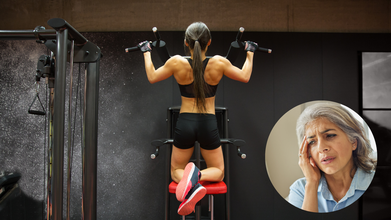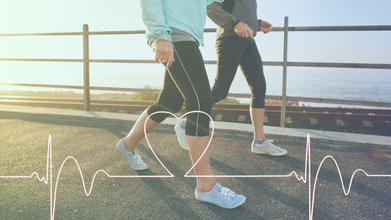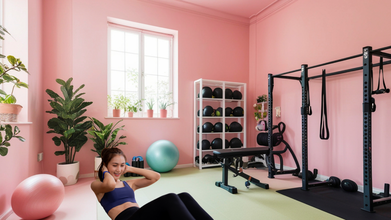- Health Conditions A-Z
- Health & Wellness
- Nutrition
- Fitness
- Health News
- Ayurveda
- Videos
- Medicine A-Z
- Parenting
- Web Stories
This Simple Grip Test Could Predict Your Dementia Risk

Credits: Canva
Dr Peter Attia, physician, and researcher known for his work in longevity medicine believes that there is a correlation between your grip strength and dementia onset risk and dementia mortality.
Dr Attia says, "My best explanation for this is that grip strength is itself a proxy for overall strength. The type of strength we are talking about here is acquired, not inherited. You had to do a bunch of work to get it, and it is the work you did that is actually what's protect your brain."
He says that women who are over 40, must be able to hand on a bar for a minute and a half, and for men, it is two minutes. The key is that you are supposed to be able to carry 75% of your weight, he says, in an interview with CBS News' 60 minutes.
Is There Any Truth In The Claim That Grip Strength Has A Correlation With Dementia?
As per a 2021 study published in journal Frontiers in Aging Neuroscience, titled Grip Strength and the Risk of Cognitive Decline and Dementia: A Systematic Review and Meta-Analysis of Longitudinal Cohort Studies, loss of grip strength and cognitive impairment are prevalent in the elderly, and they may share the pathogenesis in common.
The study found that poorer grip strength was in fact associated with more risk of cognitive decline and dementia. The subgroup analysis within the study also indicated that people with poorer strength had more risk of Alzheimer's disease and non-AD dementia.
But why does this happen? Lower grip strength is a marker for overall muscle mass, general health, and is linked to the health of the brain and its blood vessels. This link is also connected to other factors like vascular health, cognitive decline, and physical activity, as low grip strength can be a symptom of poor overall physical and metabolic health.
How Is Lower Grip Strength Is Linked To Dementia?
Indicator Of Overall Health: Grip strength reflects the health of entire body, this is why a lower grip strength is an indicate of lower muscle mass, and general poor health.
Vascular and brain health: Since there is a connection between muscle strength, blood flow, and brain health, thus lower grip strength is associated with a higher risk of vascular dementia and a greater volume of white matter hyperintensities in the brain.
Also Read: What Home Gym Tools Can Help You Stay Fit Without Hitting The Gym?
Poorer grip strength is associated with lower cognitive function, such as fluid intelligence and prospective memory. This suggest a link between the body's physical capabilities and the brain's cognitive abilities.
A different study published in 2022, where 40,000 participants from the UK Biobank were studied found that greater grip strength was associated with better cognitive functioning, higher life satisfaction, greater subjective well-being, and reduced depression and anxiety symptoms while controlling for numerous demographic, anthropometric, and socioeconomic cofounders.
The study also found that grey matter volume of subcortical region also correlated with better mental health and considerably mediated their relationship with grip strength.
One Long Walk Over Few Short Strolls Could Keep Your Heart Healthy

Credits: Canva
A new study published in the Annals of Internal Medicine suggests that you should choose one long walk over a few short strolls to keep your heart healthy. This is especially if you do not exercise much.
Walking for at least 15 minutes without a stop is ideal, notes the study. This means you walk for 1,500 steps in a row. This is said to give your heart a good workout. The study also notes that many people who walk 10,000 steps a day, actually follow the number that came from a Japanese pedometer advertisement, and not necessarily science, also reported by BBC. However, experts do agree that more steps are generally better for your health.
How Was The Study Conducted?
The study analyzed 33,560 adults who were aged 40 to 79 in the UK. They walked fewer than 8,000 steps a day. These people were grouped by how long their walks were and was measured with a step-counter over a week:
- Less than 5 minutes (43%)
- 5 to 10 minutes (33.5%)
- 10 to 15 minutes (15.5%)
- 15 minutes or more (8%)
The data was collected after tracking the participants for eight years. This was done by the researchers from the University of Sydney and the Universidad Europea in Spain.
What Did The Study Find?
The study found that people who walked in longer stretches had a lower risk of heart problems than those who take short strolls. Even those who are the least active, for instance, those who walk under 5,000 steps a day, longer walks make a big difference for them. The study noted that for them too, the risk of heart disease and death drop significantly.
However, the study cannot guarantee that this change is because they were already fitter to begin with. However, the researchers did study this factor including whether the person smoked, was obese or had high cholesterol.
How You Walk Matters More Than How Much You Walk
The researchers also noted that the way you walk could actually matter more than how much you walk. The answer is walk for a longer time, even if you do not walk that much overall. You could implement simple changes, including setting some time aside for a longer walk.
The Co-lead research Prom Emmanuel Stamatakis said, "We tend to place all the emphasis on the number of steps or the total amount of walking but neglect the crucial role of patterns, for example 'how' walking is done. This study shows that even people who are very physically inactive can maximise their heart health benefit by tweaking their walking patterns to walk for longer at a time, ideally for at least 10-15 minutes, when possible."
The National Health Service, UK, also recommends 150 minutes of moderate activity per week. This could be brisk walking, which could be spread out across the week. Older adults, especially those who are over 65, are recommended to try to move a little more every day, even if it is to do some household activities.
A senior cardiac nurse at the British Heart Foundation, Emily McGrath told BBS, "Exercise helps everyone live a happier and healthier life. If you have heart and circulatory disease, it can help you manage your condition and make you feel better overall. You may find it hard to be more active at first, but as time goes on it'll get easier as your body gets used to the activity. You may only notice small improvements at first, but it all adds up and counts towards keeping your heart healthy."
Did President Trump Have A Stroke? His Walk Suggests So, Says A 'Physical Therapist' As He Explains How Someone's Gait Can Reveal A Lot

Credits: AFP and Instagram
"He walks like this because he's had a stroke and his spatial awareness, balance, strength and gait have all been affected," says a person who claims to be a 'Physical Therapist at a home healthcare, and claims to have a doctorate in his field with 14 years of experience. The video is posted on his Instagram channel @epistemiccrisis with 74.2k followers.
What Are His Claim About President Trump's Stroke?
He claims that the reason why President Trump is Did President Trump Have A Stroke? This 'Physical Therapist' Explains Why He Believes Soall across the red carpet in a video that plays in the background is because "he lacks the spatial awareness to stay on target or on the path in a straight line".
He further says, "This is because I believe he's had a stroke that's affected the left side of his brain and caused weakness on the right side of his body. When one side of your body is weaker than the other, it can become difficult to walk in a straight line anyone. But aside from the physical weakness, your balance is affected as well."
In fact, a 2021 study published in journal Healthcare notes that stroke is a major cause of disability worldwide and balance impairments are common disabling factors in patients with stroke, which could lead to falls.
However, as per the official medical records of the president, no such strokes were mentioned. His medical report pronounced him in "excellent health". The examination was done at Walter Reed National Military Medical Center. The report also emphasized that Trump maintains a "demanding daily schedule without restriction". Not only that, the report has gone so far to declare Trump's cardiac age as 14 years younger than his actual age after an electrocardiogram.
Read More: What Does Trump's Latest Health Checkup Reveal About Him?
Though the 'Physical Therapist' believes otherwise. He says that when he went back to Walter Reed for his checkup, it was a six-week follow-up for a stroke event that "he probably had over Labor Day". "A stroke on the left side of the brain would also explain why he talks nonsense so much more often nowadays and also why when he is fatigued after long travel like you see in that video, his speech is much slower, much quieter and much more slurred," he claims.
The 'Physical Therapist' further claims that being 80-years old, Trump is also experiencing age-related cognitive decline.
Read: Why Is This Doctor Asking President Trump To Take Alzheimer's Test?
Have Their Been Other Claims On President Trump's Health?
Previously, Dr Narinder Kapur, a consultant neuropsychologist and visiting professor at the University College London said that president's behavior over the last six months has been "quite odd and strange," as reported by Express, UK. He said that there may be a possibility of frontotemporal dementia, that the President must take a test for.
There were also claims about President's 'riddled with arthritis' condition and the need for a double hip replacement surgery. Furthermore, Kai Trump, president's granddaughter's latest Instagram post have also raised questions abut his health, especially the hand bruise.
This is not the first time the 'Physical Therapist' from the account @epsitemiccrisis has made a claim about president Trump. In the past, he linked president's use of smaller stairs to climb to the aircraft with having a stroke. He said that he is using smaller sets of stair so "the public won't notice that he's had a stroke". He explains that when someone's had a stroke, it can involve paralysis of the perineal nerve. This bends your foot up towards your head during your walking. If this nerve is paralyzed, you get a "foot drop". He also claimed that the same thing happened with Joe Biden as he also changed with smaller sets of stairs.
However, none of his claims have been attributed, and the White House does medical reports do not corroborated any of such news.
Note: This piece is based on the claims made by the account @epistemiccrisis. Health And Me does not authenticate any of these claims.
What Home Gym Tools Can Help You Stay Fit Without Hitting The Gym?

Credits: Canva
We all know working out had great benefits, but do you also sometimes feel too lazy to go to the gym? Well, you can now work out at your home. For many, the idea of hitting the gym, or waiting for your turn to use the machine, or just dealing with crowd in general could derail the motivation. But, the good news is that there are tools you can buy and set your own home gym.
Bollywood actor Kareena Kapoor Khan's fitness trainer Mahesh Ghanekar also swears by such high-impact equipment. We have shortlisted 8 must have home gym tools from his list that you must have!
Dumbbells
This is a classic one, but is of course a classic strength builder. If there’s one piece of equipment that should top your list, it’s a good pair of dumbbells. Ghanekar recommends a range from 2.5 kg to 20 kg, depending on your level.
Dumbbells help target every major muscle group, from shoulders to glutes, and can be used for both toning and compound movements like squats and presses. Studies also show that free-weight exercises with dumbbells improve muscle coordination and strength more effectively than machines.
Kettlebell
Another classic, and it helps with both strength and endurance. It is compact, but the impact is powerful. They are a great equipment for dynamic movements like swings, snatches, and squats. Ghanekar suggests that you can start with a 5 to 12 kg kettlebell for home use.
Resistance Bands
While they seem easy, they are the best equipment for portable gym. They are most versatile and space-saving workout tools. You can use them for strength training, stretching, or even rehabilitation.
According to Ghanekar, they’re perfect for beginners and advanced exercisers alike because they engage stabilizing muscles and improve flexibility, all without putting too much strain on joints.
Jump Rope
The best way to do cardio at home is by jumping rope. A jump rope is one of the best cardio tools you can own. It enhances coordination, burns calories fast, and boosts cardiovascular health.
Just ten minutes of skipping can match the benefits of a 30-minute jog, says Ghanekar. It’s small, portable, and easy to store, making it an ideal home essential.
Adjustable Bench
An adjustable bench allows you to perform a variety of exercises like presses, step-ups, or core work.
Ghanekar says that the incline and decline positions help activate different muscle areas, especially the chest and arms, allowing a more rounded strength routine at home.
Yoga Mat
A yoga mat is more than just for yoga. It’s a must-have for stretching, pilates, or even bodyweight exercises.
Ghanekar recommends investing in a thick, non-slip mat to improve posture, prevent injuries, and create a dedicated space for mindfulness and recovery.
Foam Roller
Post-workout recovery is as important as training. A foam roller helps release tight muscles, improve circulation, and prevent soreness.
Ghanekar says regular foam rolling can enhance flexibility and speed up recovery, allowing you to stay consistent with your workouts.
Stepper
A simple stepper or aerobic platform is a great way to tone your legs, improve balance, and get your heart pumping.
Ghanekar highlights that stepping workouts improve lower-body endurance and cardiovascular fitness, and can even reduce body fat when done consistently.
© 2024 Bennett, Coleman & Company Limited

